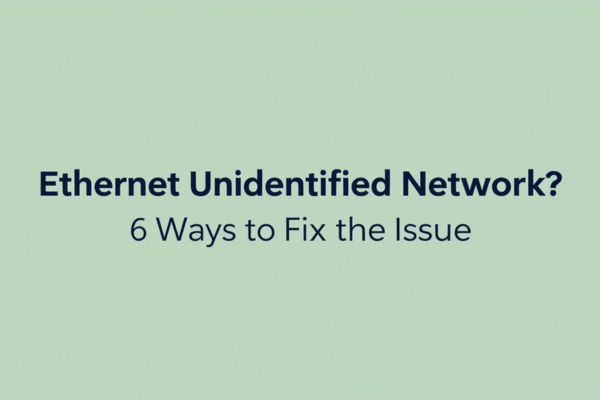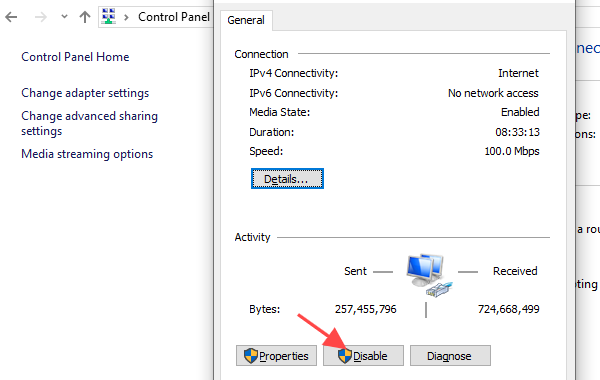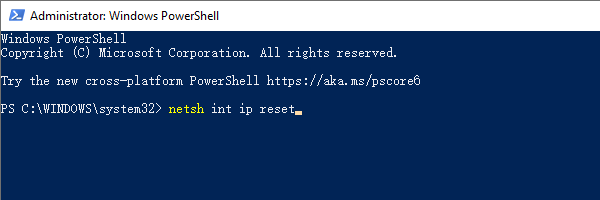If you've ever seen the "ethernet unidentified network" error on your computer, you know how frustrating it can be. It's that annoying message that pops up when you're trying to get online via an Ethernet connection, but your computer just can't seem to figure out what's going on. You might have a perfectly good Ethernet cable plugged in, but you still can't access the internet. Don't worry, though! In this blog, we'll show you six effective ways to fix this problem and get you back online in no time.

What Causes the Ethernet Unidentified Network?
Before we jump into the solutions, let's quickly look at what might be causing this "unidentified network ethernet" issue. There are a few common culprits. It could be a problem with your network drivers. Outdated or corrupted drivers can prevent your computer from communicating properly with the Ethernet network. Another possibility is a hardware issue. Maybe the Ethernet cable is damaged, or there's a problem with the Ethernet port on your computer or router. Sometimes, incorrect network settings or conflicts can also lead to the "unidentified network ethernet" error.
6 Ways to Fix the Ethernet Unidentified Network Issue
Method 1: Reboot Router and Computer
This is one of the simplest yet most effective things you can try. Sometimes, little glitches in your router or computer can cause the "ethernet cable unidentified network" problem.
First, turn off your router and modem. Just unplug them from the power source. Then, shut down your computer completely. It's important to give everything a good rest. Wait for at least 5 minutes. This gives the devices time to fully power down and clear any temporary issues.
After 5 minutes, plug the router and modem back in. Wait for them to fully boot up. Then, turn on your computer. Check if your Ethernet connection is working. If it is, great! You're back online. If not, don't worry. We have more solutions for you.

Method 2: Update Network Drivers
Outdated network drivers can be a major cause of the "ethernet unidentified network" problem. PcGoGo Driver Sentry is a great tool that can automatically find and install the latest drivers for your network adapter.
First, head over to the PcGoGo website and click the download link to get the latest version of Driver Sentry. Once it's installed, open the software. You'll see a section called "Drivers". Click the "Scan" button there.
PcGoGo Driver Sentry will then start scanning your system for any outdated or missing drivers, especially those related to your network adapter. When the scan is done, it will show you a list of drivers that need updating. Look for the one related to your network adapter. If there's a new driver available, click "Upgrade" to install it.
After the update is complete, restart your computer. This helps the new driver take effect. Check if the "ethernet unidentified network" error is gone. Chances are, updating the driver will solve the problem.
Method 3: Re-enable Ethernet Adapter
Sometimes, your Ethernet adapter can get stuck in a bad state. Disabling and re-enabling it can often fix this.
Press the Windows key and "R" at the same time. This will open the Run dialog box. Type "ncpa.cpl" and hit Enter. This will open the Network Connections window.
In the Network Connections window, find your Ethernet adapter. Right-click on it and select "Disable". Wait for a few seconds. This gives the adapter time to turn off. Subsequently, right-click on it once more and choose "Enable".
Now, check if your computer can recognize the Ethernet network. If it can, you're all set. If that doesn't work, proceed to the next approach.

Method 4: Run Windows Troubleshooter
Windows has a built-in network troubleshooter that can help you find and fix network problems. It's easy to use.
Press the Windows key and "I" to open the Settings app. In the Settings app, go to "Network & Internet". Then, click on "Status".
Scroll down until you see "Network troubleshooter" and click on it. Windows will then start diagnosing your network problems. Just follow the on-screen instructions. Windows will try to find and fix any issues it discovers.
If the troubleshooter finds and fixes the problem, your Ethernet connection should start working normally. If it doesn't, don't give up. There are still more things you can try.
Method 5: Reset Network Configuration
If there are issues with your network configuration or the TCP/IP stack, it can cause the "ethernet unidentified network" error. Resetting these settings might solve the problem.
Press the Windows key and "X" at the same time. Then, select "Windows PowerShell (Admin)". This will open the Windows PowerShell with administrative privileges.
In the Windows PowerShell, type the following commands one by one, pressing Enter after each:
- netsh int ip reset
- netsh winsock reset
- ipconfig /release
- ipconfig /renew
- ipconfig /flushdns
After you've entered all the commands, restart your computer. Then, check if your Ethernet connection is working. This reset can often clear up any configuration issues and get your network up and running again.

Method 6: Check the Ethernet Cable & Port
A faulty Ethernet cable or port can also be the cause of the problem. First, try using a different Ethernet cable. Sometimes, the cable can get damaged, which stops the network connection.
If you have another Ethernet cable, plug it into your computer and the router or modem. See if that fixes the “ethernet cable unidentified network” problem. Also, try plugging the cable into a different Ethernet port on your router or modem. It's possible that the original port is faulty.
If you have another device, like a laptop, try connecting it to the same network using the same cable and port. If the other device can connect to the network, then the problem is likely with your original computer. It could be a software or hardware issue with the Ethernet adapter on that computer.
Conclusion
The "ethernet unidentified network" problem can be a real pain, but with these six methods, you should be able to fix it. Whether it's restarting your devices, updating your drivers with PcGoGo Driver Sentry, or checking your hardware, there's a good chance you'll get your Ethernet connection working again. If you've tried all these methods and you're still having trouble, it might be time to contact your internet service provider or a professional technician. But most of the time, these simple fixes will do the trick. So, give them a try and get back to enjoying a smooth, reliable Ethernet connection.